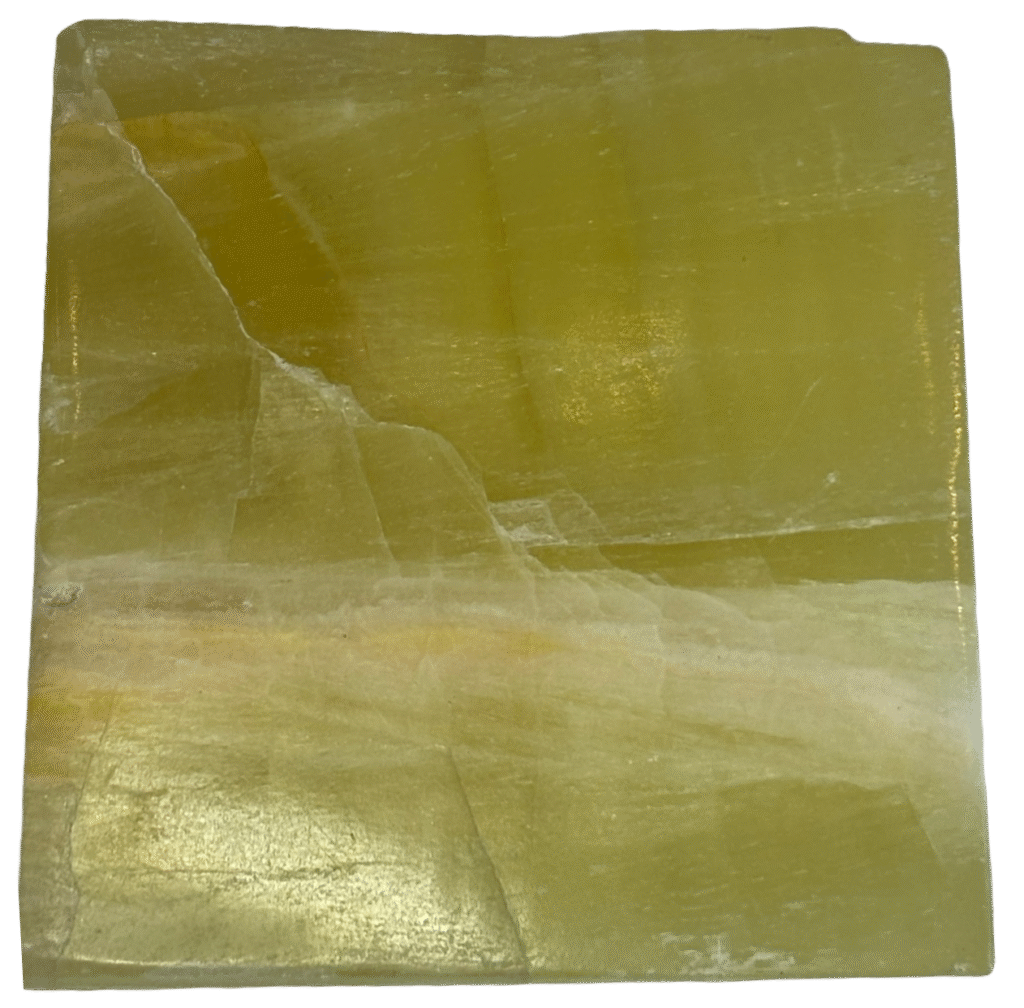
Honey Calcite derives its name from its rich golden hues, reminiscent of honey. The term “Calcite” comes from the Latin word “calx,” meaning lime, as it is a primary component of limestone. It is sometimes referred to as Golden Calcite or Amber Calcite due to its warm, translucent shades.
Composition and Physical Characteristics
Honey Calcite is a calcium carbonate mineral with the chemical formula CaCO₃. It forms in a trigonal crystal system and commonly exhibits rhombohedral cleavage. Its hardness on the Mohs scale is approximately 3, making it relatively soft and susceptible to scratching. It has a vitreous to pearly lustre and can be transparent to translucent. Honey Calcite often contains internal veining or banding and may fluoresce under ultraviolet light.
Varieties of Honey Calcite
- Golden Honey Calcite: A deep golden to amber-coloured variety, sometimes with internal clarity.
- Optical Honey Calcite: Displays double refraction, meaning light passing through it appears doubled.
- Banded Honey Calcite: Features natural layering with varying shades of gold and brown.
Locations
Honey Calcite is found in various regions worldwide, with significant deposits in:
- Mexico (notably in Chihuahua and Durango)
- The United States (notably in Arizona and Texas)
- China
- Brazil
- Peru
- Madagascar
Archaeological and Significant Finds
Calcite, including Honey Calcite, has been used throughout history in ancient architecture and artefacts. It was employed in Egyptian tomb carvings, Roman sculptures, and even in medieval alchemy. The discovery of large, high-quality Honey Calcite deposits in Mexico significantly increased its availability for metaphysical and decorative purposes.
Historical and Current Usage
Historically, calcite was used in lime production for mortar and plaster. Honey Calcite, due to its striking colour, has been used in decorative carvings and jewellery. Today, it is widely appreciated in crystal healing, meditation, and ornamental collections.
Interesting Facts
- Honey Calcite is known for its strong birefringence, where objects viewed through the crystal appear doubled.
- It has been used as a teaching tool for understanding light refraction.
- Some high-quality specimens are used in optical instruments and lenses.
Folklore, Legends, and Tales
Ancient civilisations associated calcite with the sun, believing it carried the essence of solar energy. In some cultures, Honey Calcite was considered a stone of enlightenment, aiding philosophers and scholars in their pursuits of knowledge.
Mystical Healing Properties
Honey Calcite is believed to:
- Enhance mental clarity and focus.
- Strengthen confidence and motivation.
- Support personal willpower and courage.
- Promote balance and grounding in energy work.
- Aid in overcoming fears and self-doubt.
Astrology and Zodiac Links
Honey Calcite is often associated with the zodiac signs:
- Leo: Enhancing leadership and personal strength.
- Cancer: Providing emotional balance and security.
- Virgo: Encouraging focus and intellectual clarity.
Chakra System Connections
Honey Calcite resonates with:
- Solar Plexus Chakra (Manipura): Boosting confidence and personal power.
- Sacral Chakra (Svadhisthana): Enhancing creativity and emotional harmony.
Birthstone and Wedding Anniversary Link
While not a traditional birthstone, Honey Calcite is sometimes used as an alternative for those born in autumn months due to its warm golden hues. It is also associated with the 13th wedding anniversary as a symbol of resilience and energy.
Honey Calcite remains a cherished gemstone for its beauty, history, and metaphysical significance, making it a valuable addition to any collection.
